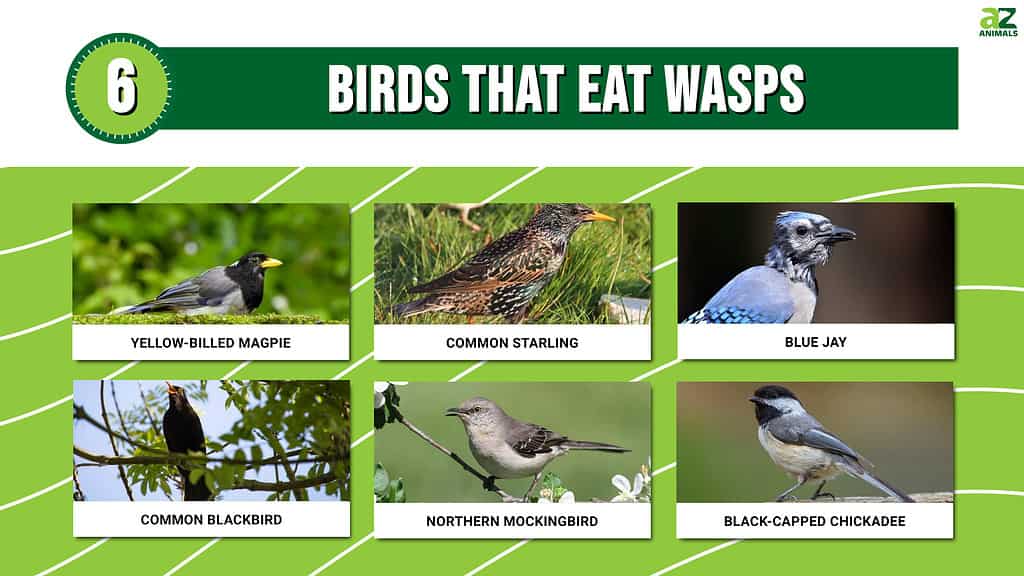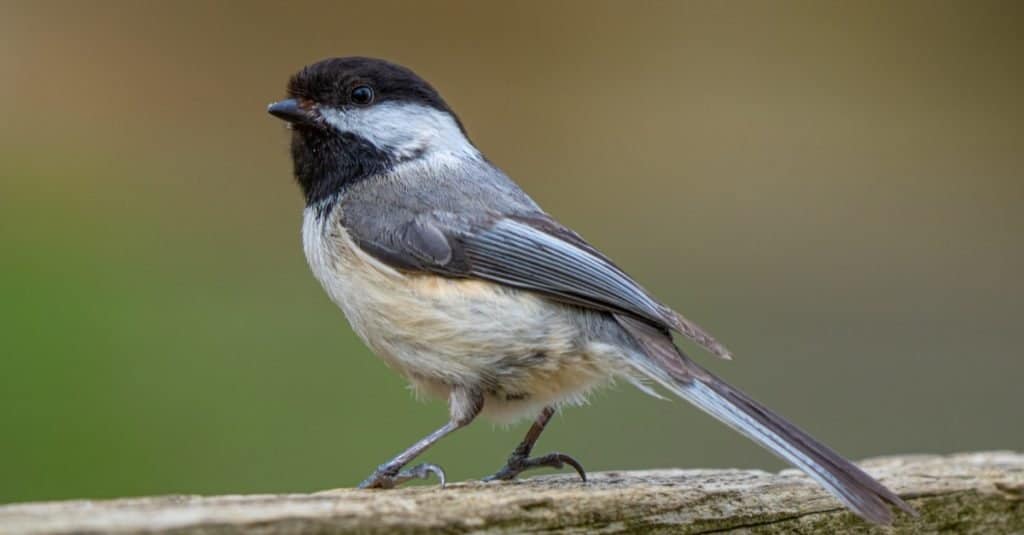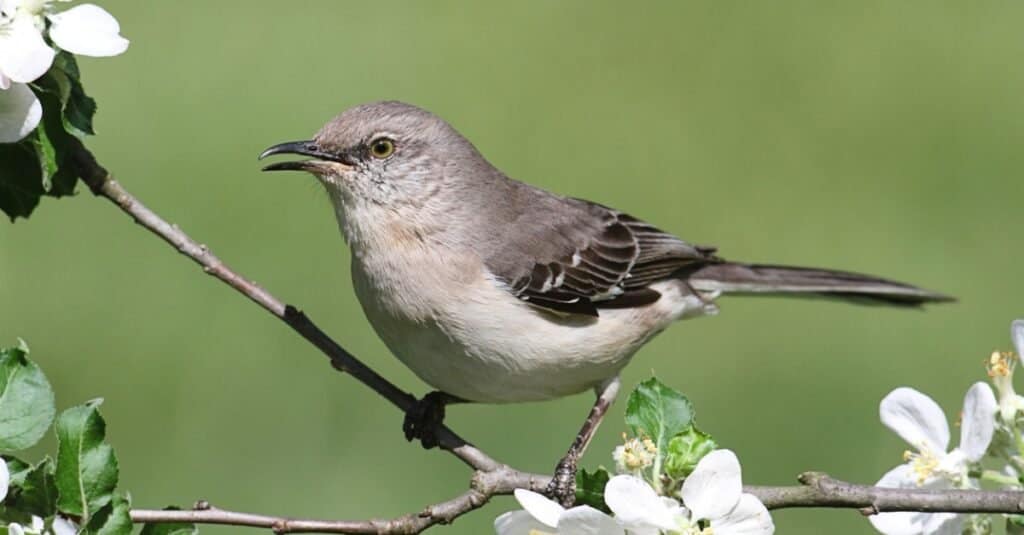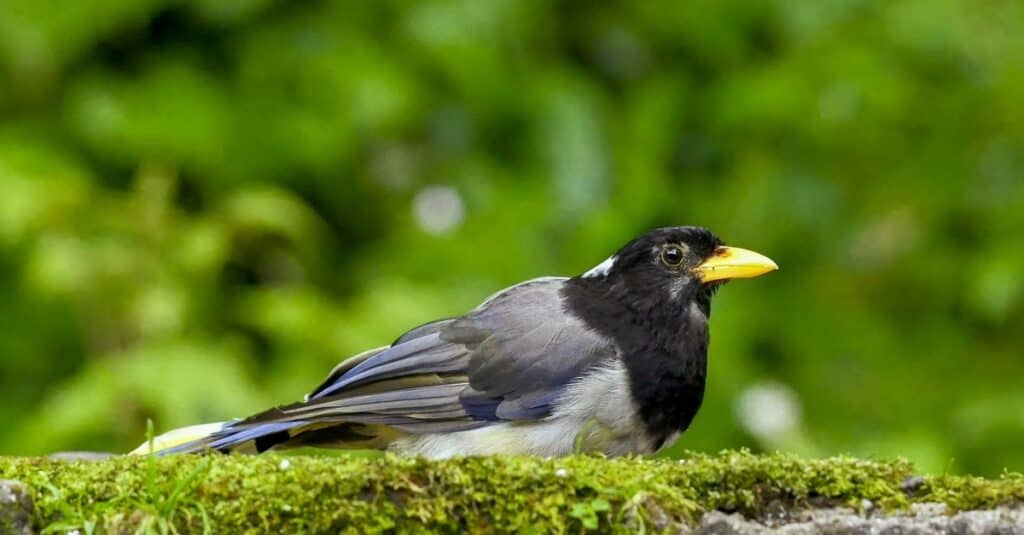Of all the insects in the animal kingdom, few fill people with as much dread as wasps. Wasps make up a very diverse group of insects, with around 30,000 species currently identified by scientists. While most pose little threat to humans aside from a painful sting, some possess lethal amounts of toxin. As a result, many people fear wasps, especially those with allergies or an underlying health condition. To rid their backyards and living spaces of wasps, many people turn to chemical repellants and traps. While sometimes effective, these traps don’t always work, and many include substances that harm the environment. Luckily, there exists a number of natural options to reduce wasp numbers. The best methods of wasp deterrence include the abundance of birds that eat wasps.
In this article, we’ll cover some of the birds that most commonly prey on wasps as part of their regular diet. We’ll also discuss where you can find these birds and what they look like so you can identify them. Hopefully, next time you have a backyard barbecue, one of these birds will be nearby. That way, your barbecue can stay wasp-free while you enjoy a well-earned meal in peace. So, let’s begin and discuss 6 different birds that eat wasps.

#6: Black-Capped Chickadee

Black-capped chickadees have amazing memories and can remember where they cached food for weeks.
©J.A. Dunbar/Shutterstock.com
The black-capped chickadee is a small songbird in the tit family Paridae. Unlike many other songbirds, the black-capped chickadee does not migratory. Instead, it lives year-round in the forests of Alaska, Canada, and the northern United States. They can tolerate cold weather because of their ability to lower their metabolism and body temperature during winter. On average, they measure 4.7 to 5.9 inches long and possess short, rounded wings and a long tail. Black-capped chickadees get their name from the black plumage on their head and neck. Meanwhile, they feature white feathers on their cheeks and breast, golden sides, and black and white wings. Their diet consists mostly of insects, and they are one of the birds that eat wasps in large numbers. During winter, they resort to relying on cached seeds and insects. They possess amazing memories and can remember a cache location for nearly a month.
#5: Northern Mockingbird

Northern mockingbirds have an uncanny ability to imitate the songs of other birds.
©Steve Byland/Shutterstock.com
The northern mockingbird is a mockingbird in the family Mimidae commonly found in North America. While its habitat varies, the northern mockingbird usually prefers to live in open areas. You can frequently find them in urban and suburban areas, as well as grasslands, parks, and sparsely forested areas. Well-known for its powers of mimicry, a northern mockingbird can learn up to imitate up to 200 individual sounds. In fact, its scientific name, Mimus polyglottos, translates to “many-tongued thrush.” Generally, they measure around 8.1 to 11 inches long, with a wingspan between 12 to 15 inches. They sport light gray upperparts, white underparts, and black and white markings on their wings. Northern mockingbirds are omnivores and will eat a wide variety of insects, fruits, and seeds. That said, you can find these birds that eat wasps frequently raiding wasps nests for grubs.
#4: Common Blackbird

Blackbirds will drag wasps across the ground to remove their stingers.
©Estuary Pig/Shutterstock.com
Also known as the Eurasian blackbird, the common blackbird is a member of the thrush family Turdidae. Despite its name, it bears little in common with the New World blackbirds of the family Icteridae. The common blackbird ranges throughout Europe, Russia, North Africa, parts of Australia, and New Zealand. They typically breed in forested areas but also build their cup-shaped nests in suburban parks and gardens. Male common blackbirds appear all-black except for the yellow rings around their eyes and hooked yellow beak. Due to their distinctive look, they feature prominently in many nursery rhymes, folktales, and cultural traditions. Their diet consists of insects, worms, seeds, and berries, although they will also eat small amphibians and mammals. Of the birds that eat wasps, common blackbirds will purposely hunt down and destroy a wasp’s nest. Prior to eating a wasp, they may drag it across the ground to remove its stinger.
#3: Blue Jay

Blue jays will aggressively hunt down and eat wasps.
©iStock.com/Carol Hamilton
The blue jay is a member of the Corvidae family of crows, jays, magpies, rooks, and ravens. It lives in forested areas throughout southern Canada, the United States, and northern Mexico. However, it’s also a common sight in residential and suburban areas. On average, they measure 9 to 12 inches long and sport a visible crown on their heads. As its name implies, the blue jay features both light and dark blue plumage on its back, head, and wings. Meanwhile, its face and underparts appear white. Blue jays can act quite aggressively and will attack other birds if they intrude in their territory. While they predominantly eat seeds, berries, nuts, and grains, blue jays will also target insects. In particular, blue jays will hunt down and eat wasps. Although they can’t fly quickly, they will make short work of a nest and feast on any larvae inside.
#2: Common Starling

Common starlings roost in large communities, and when feeding can devastate local wasp and other insect populations.
©iStock.com/Imogen Warren
Also known as the European starling, the common starling, or simply starling, is a member of the starling family Sturnidae. While native to Europe, Asia, and Africa, you can now find common starlings in North and South America and Australia. On average, they measure 7.5 to 9 inches long with a wingspan between 12 to 17 inches. Depending on the lighting, their distinctive, iridescent black plumage can appear purple or green. They can be quite noisy, especially when roosting in large numbers during the winter. At their largest, roosts can contain up to 1.5 million birds. Common starlings primarily subsist on insects such as spiders, flies, bees, beetles, and ants. They are also one of the birds that eat wasps, and will specifically target wasp nests for their larvae. Whether on the ground or in the air, common starlings will make short work of any wasps they encounter.
#1: Yellow-Billed Magpie

The yellow-billed magpie is a vulnerable wasp-eating bird endemic to California.
©iStock.com/Banu R
The yellow-billed magpie is a member of the family Corvidae along with the blue jay. It can only be found in the state of California, and as such is listed as Vulnerable by the IUCN. In particular, yellow-billed magpies live in the foothills and mountains surrounding the Central Valley. Known for their gregarious nature, yellow-billed magpies roost communally and can act quite social. In fact, when a member of a roost dies, the other members may gather around its body and “cry.” Yellow-billed magpies sport a black head, back, and neck, white underparts, and black wings. You can distinguish them from the black-billed magpie due to their distinctive yellow beak. They eat a variety of foods including seeds and nuts but primarily eat insects. Yellow-billed magpies love to eat wasps and will gobble down both adults and larvae alike with relish.
Summary of 6 Birds That Eat Wasps
| Bird | Locale | |
|---|---|---|
| 1 | Yellow-Billed Magpie | California |
| 2 | Common Starling | Europe, Asia, Africa, North & South America, Australia |
| 3 | Blue Jay | United States, Southern Canada, Northern Mexico |
| 4 | Common (Eurasian) Blackbird | Europe, Russia, North Africa, parts of Australia, and New Zealand |
| 5 | Northern Mockingbird | North America |
| 6 | Black-Capped Chickadee | Northern U.S., Alaska, Canada |
The photo featured at the top of this post is © iStock.com/BrianEKushner
Thank you for reading! Have some feedback for us? Contact the AZ Animals editorial team.






